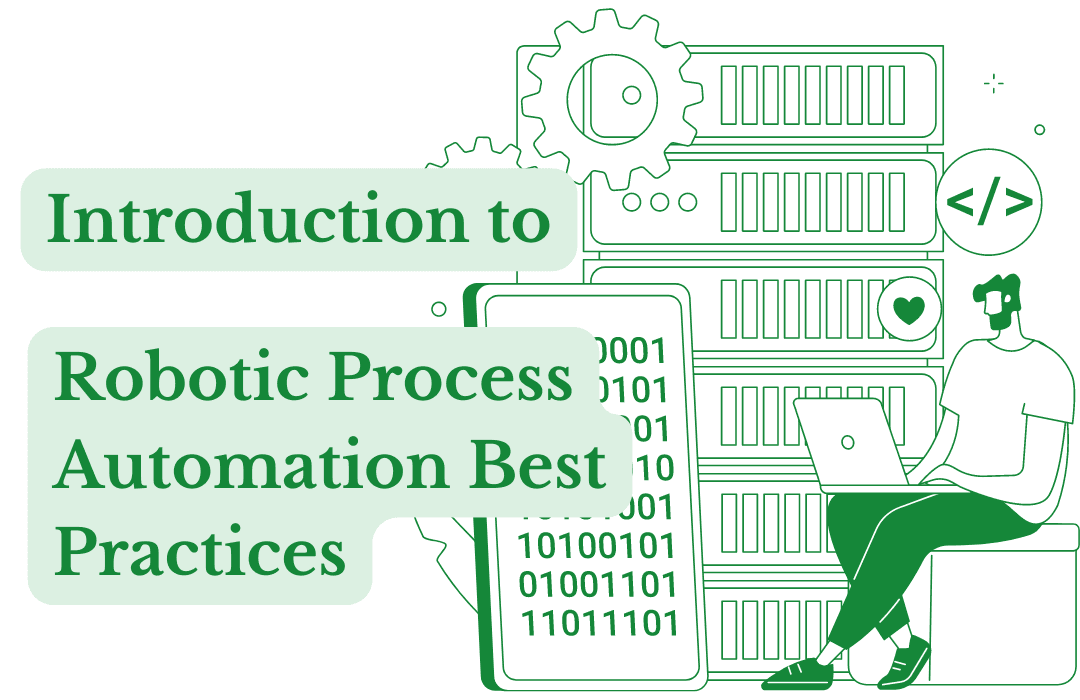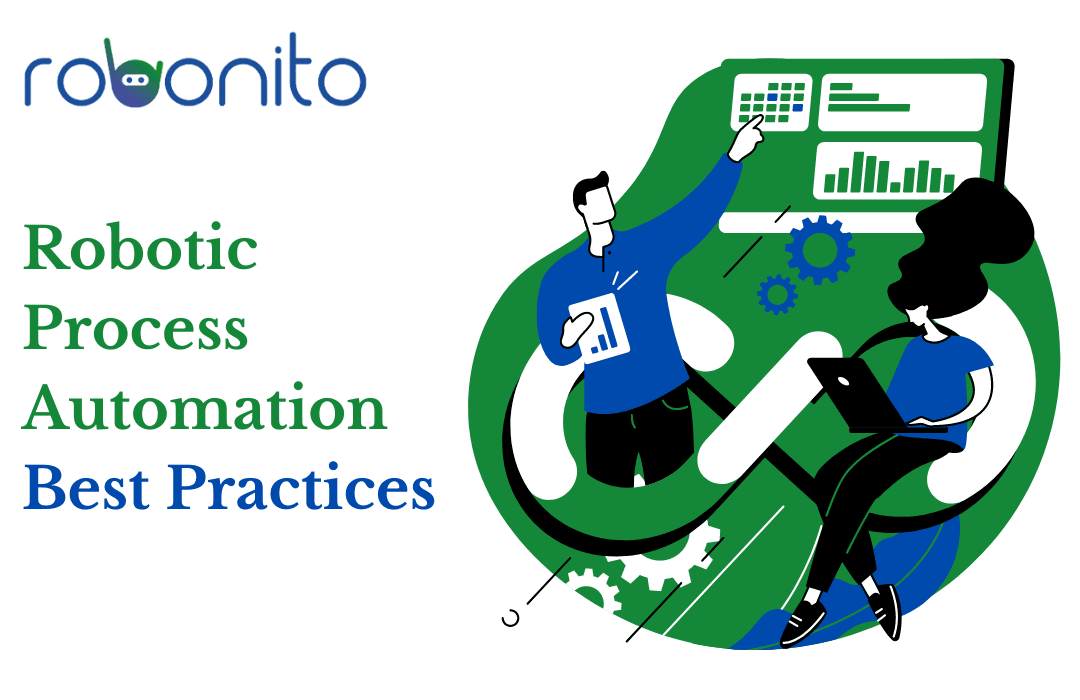This article explores the top Robotic Process Automation Best Practices To adopt in 2023, covering aspects such as process identification, collaboration, data security, continuous improvement, and future trends. Discover the key strategies to stay ahead in the rapidly evolving world of RPA. In today's digital age, businesses are constantly seeking innovative ways to streamline their operations and improve efficiency. Robotic Process Automation (RPA) has emerged as a powerful tool that allows organizations to automate repetitive and rule-based tasks, freeing up human resources for more value-added activities. However, implementing RPA requires careful planning and adherence to best practices to ensure successful outcomes.
Introduction to Robotic Process Automation

Robotic Process Automation, or RPA, is a technology that enables organizations to automate repetitive tasks by using software robots or "bots." These bots mimic human actions, interacting with applications and systems to execute tasks accurately and efficiently. RPA offers numerous benefits, including increased productivity, improved accuracy, cost savings, and enhanced customer experience.
what are the benefits of RPA
Robotic Process Automation (RPA) offers a wide range of benefits for organizations. Let's explore the key advantages of implementing RPA:
Increased Efficiency and Productivity: RPA eliminates manual intervention in repetitive, rule-based tasks, allowing software robots to perform them with greater speed and accuracy. By automating such tasks, RPA frees up employees' time, enabling them to focus on more strategic and value-added activities. This leads to increased efficiency and productivity within the organization.
Cost Savings: RPA reduces operational costs by minimizing the need for human labor. Software robots can handle tasks round the clock without the need for breaks, resulting in cost savings associated with human resources. Moreover, RPA reduces the risk of errors and rework, which can be costly to rectify. Overall, RPA offers a cost-effective solution for organizations.
Improved Accuracy and Quality: Humans are prone to errors, particularly when performing repetitive tasks. RPA ensures consistent and accurate task execution, reducing the risk of mistakes. By eliminating human errors, organizations can deliver high-quality outputs, leading to enhanced customer satisfaction and improved business reputation.
Enhanced Scalability: RPA allows organizations to scale their operations quickly and efficiently. As business needs change, software robots can be easily deployed or reconfigured to accommodate increased work volumes. RPA provides flexibility in handling fluctuating demands, enabling organizations to optimize their resources and meet customer expectations.
Faster Process Cycle Times: RPA accelerates process cycle times by eliminating delays caused by manual handoffs and data entry. Software robots can perform tasks at a significantly faster pace, leading to quicker turnaround times and reduced process bottlenecks. This enables organizations to enhance their operational efficiency and achieve faster time-to-market.
Improved Compliance: In industries with stringent regulatory requirements, RPA ensures compliance by automating rule-based processes. Software robots can be programmed to adhere to predefined rules and regulations, reducing the risk of non-compliance. RPA also provides a transparent audit trail, simplifying compliance management and mitigating regulatory risks.
Employee Empowerment: RPA empowers employees by automating repetitive and mundane tasks, allowing them to focus on more meaningful and intellectually challenging work. By offloading mundane responsibilities to software robots, employees can utilize their skills in areas that require human creativity, problem-solving, and critical thinking. This enhances job satisfaction, fosters employee morale, and promotes professional growth.
Improved Customer Service: RPA enhances customer service by automating customer-facing processes. Software robots can handle inquiries, process orders, and provide personalized responses, leading to faster response times and improved customer satisfaction. By delivering a seamless customer experience, organizations can strengthen customer loyalty and gain a competitive edge.
Data Accuracy and Insights: RPA ensures accurate and reliable data exchange between systems by seamlessly integrating with existing applications. This enables organizations to make data-driven decisions based on real-time information. RPA can also collect and analyze large volumes of data, providing valuable insights for process optimization and strategic decision-making.
Competitive Advantage: Organizations that embrace RPA gain a competitive edge in their industry. By automating processes, reducing costs, and improving operational efficiency, organizations can deliver superior products and services to their customers. RPA allows organizations to focus on innovation, customer experience, and strategic initiatives, positioning them ahead of competitors.
In conclusion, RPA offers multiple benefits, including increased efficiency, cost savings, improved accuracy, scalability, and enhanced customer service. By leveraging RPA, organizations can optimize their operations, drive innovation, and gain a competitive advantage in today's dynamic business landscape.
Robotic Process Automation Best Practices To Do In 2023
Identifying the Right Processes for Automation
Before embarking on an RPA journey, it is crucial to identify the right processes for automation. Not all processes are suitable for RPA, and organizations should prioritize tasks that are repetitive, rule-based, and high in volume. Conducting a thorough process assessment and feasibility study will help determine the potential benefits and ROI of implementing RPA.
Building a Strong Foundation
To ensure successful implementation, organizations need to establish a strong foundation for RPA. This includes creating a dedicated team responsible for RPA initiatives, establishing governance and standards, and defining a clear automation strategy aligned with business objectives. It is also essential to involve relevant stakeholders and provide comprehensive training to employees who will work alongside the bots.
Ensuring Data Quality and Security
Data quality and security are paramount when implementing RPA. Organizations should implement strict data access controls, encryption mechanisms, and regular backups to protect sensitive information. Additionally, continuous monitoring and audits should be performed to identify and address any potential vulnerabilities or breaches.
Collaboration between Humans and Robots
While RPA can automate repetitive tasks, it is essential to foster collaboration between humans and robots. Employees should be encouraged to work alongside the bots, leveraging their capabilities to focus on higher-value activities that require human judgment, creativity, and critical thinking. Establishing effective communication channels and providing ongoing support and training will ensure a smooth transition and maximize the benefits of RPA.
Continuous Improvement and Maintenance
RPA is not a one-time implementation; it requires continuous improvement and maintenance. Regular reviews and assessments should be conducted to identify opportunities for optimization and refinement. Organizations should have mechanisms in place to collect feedback from employees and end-users to address any issues promptly. Continuous learning and upskilling of the RPA team are crucial to stay updated with the latest developments in the field.
Measuring and Monitoring RPA Performance
To gauge the effectiveness of RPA, organizations must establish performance metrics and monitoring mechanisms. Key performance indicators (KPIs) should be defined and tracked to assess the impact of automation on productivity, accuracy, cost savings, and customer satisfaction. Real-time monitoring tools can provide insights into bot performance, identify bottlenecks, and enable proactive interventions.
Overcoming Challenges and Pitfalls
Implementing RPA may come with challenges and pitfalls that organizations need to address proactively. Some common challenges include process standardization, change management, resistance from employees, and integration complexities. By fostering a culture of innovation, providing adequate training and support, and addressing concerns transparently, organizations can overcome these challenges and ensure a smooth RPA implementation.
Future Trends in Robotic Process Automation
The field of RPA is continuously evolving, and several future trends are shaping its landscape. Artificial Intelligence (AI) and Machine Learning (ML) integration with RPA are expected to enhance the capabilities of automation, enabling intelligent decision-making and advanced process analytics. Hyperautomation, which combines RPA with other automation technologies, is another emerging trend that will further revolutionize how organizations operate and optimize their processes.
Conclusion on Robotic Process Automation Best Practices
Robotic Process Automation offers tremendous potential for organizations seeking to optimize their operations and achieve higher levels of efficiency. By following the best practices outlined in this article, organizations can ensure successful RPA implementations, maximize the benefits of automation, and drive sustainable growth in the digital era.
Revolutionize your software testing with Robonito, the ultimate no-code RPA automation testing tool. Say goodbye to endless testing hours – Robonito slashes testing time by a staggering 98%! Ready to experience the future of software testing? BOOK A FREE DEMO NOW and transform your testing process today!
FAQs on Robotic Process Automation Best Practices
1. What are the benefits of Robotic Process Automation? Robotic Process Automation offers benefits such as increased productivity, improved accuracy, cost savings, enhanced customer experience, and the ability to free up human resources for higher-value activities.
2. How do I identify the right processes for automation? To identify the right processes for automation, organizations should focus on tasks that are repetitive, rule-based, and high in volume. Conducting a thorough process assessment and feasibility study will help determine the potential benefits and ROI of implementing RPA.
3. How can organizations ensure data security when implementing RPA? To ensure data security, organizations should implement strict data access controls, encryption mechanisms, regular backups, and continuous monitoring. It is crucial to address any potential vulnerabilities or breaches promptly.
4. How can humans collaborate effectively with robots in an RPA environment? Effective collaboration between humans and robots can be fostered by encouraging employees to work alongside the bots and leverage their capabilities for higher-value activities. Establishing communication channels and providing ongoing support and training are also essential.
5. What are some future trends in Robotic Process Automation? Future trends in RPA include AI and ML integration, enabling intelligent decision-making and advanced analytics. Hyperautomation, combining RPA with other automation technologies, is also an emerging trend that will reshape organizational processes.
